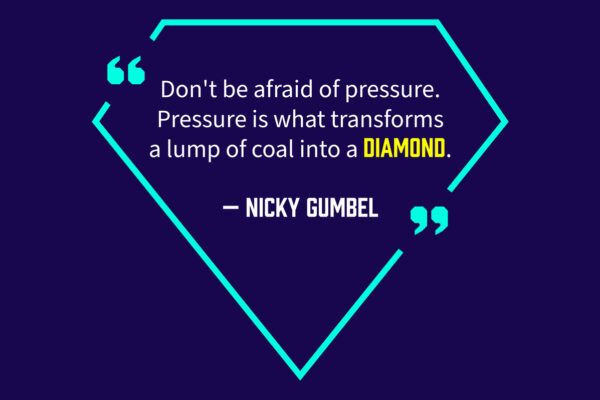Pressure And Performance
As an agency we pride ourselves on being a nice place to work. In fact, I just finished a blog tooting about some of the ways in which I’m proud of our Culture of Engagement. One of our values is to be nurturing and yet I’m about to talk about applying pressure and making diamonds.
We have a group exercise I wheel out every now and again where we list all the pressures we get from our jobs, for example:
- Control (how much say a person has)
- Change (How organisational change is managed and communicated)
- Demands (Workload, work culture)
- Role (clarity on employee’s responsibilities)
- Support (what support you have among colleagues, Line Managers, Training support)
- Relationships (behaviour towards colleagues)
Culture (how company as a whole supports and treats its employees)
We talk about how all these components make us feel small, stressed and the detrimental effect it has on your self esteem and work function. We all agree how adding in these pressures creates poor results, poor performance.
My next group exercise is to ask the same question, only this time I ask what makes for a high performance. Oddly some of those same examples above pop up here too:
- Communication – clear tasks and direction from colleagues and leaders
- Sense of urgency – deadlines
- Peer pressure – inspiring colleagues, wanting to keep up with team mates
- Support/Healthy challenges – encouragement and pride in your work
- Clear role definition
We conclude that the types of pressures we receive at work can make low or high performances, it’s how you apply those pressures and knowing when to stop (or start).

If you look at the Pressure and Performance Curve above, originally created by Robert Yerkes and John Dodson in 1908, you can see that pressure can be a positive influence – as long as it is the right amount. Too little pressure and there is a sense of apathy and boredom and work levels suffer. Far too much pressure and you are overwhelmed and stressed and the performance starts to drop off again.
At Goram & Vincent we often refer to this diagram. We herald ‘Stretch’ as the diamond state.
Minimum pressure = Boredom, procrastination, getting distracted
Maximum pressure = Overwhelm, agitation, anxiety and stress
Stretch = A sweet spot of Balance, Wellbeing and Growth
We now have a set of vocab that we all understand and can articulate without feeling ashamed or unable to communicate. Naturally we all have our own curve of pressure and performance so it’s helpful signposting, knowing we all need different dollops of pressure.
So full circle – pressure can be nurturing, in fact too little pressure and we aren’t nurturing enough.



Comments
Add comment